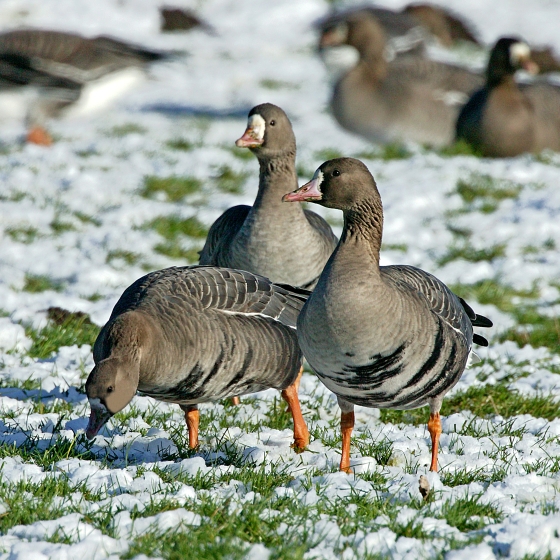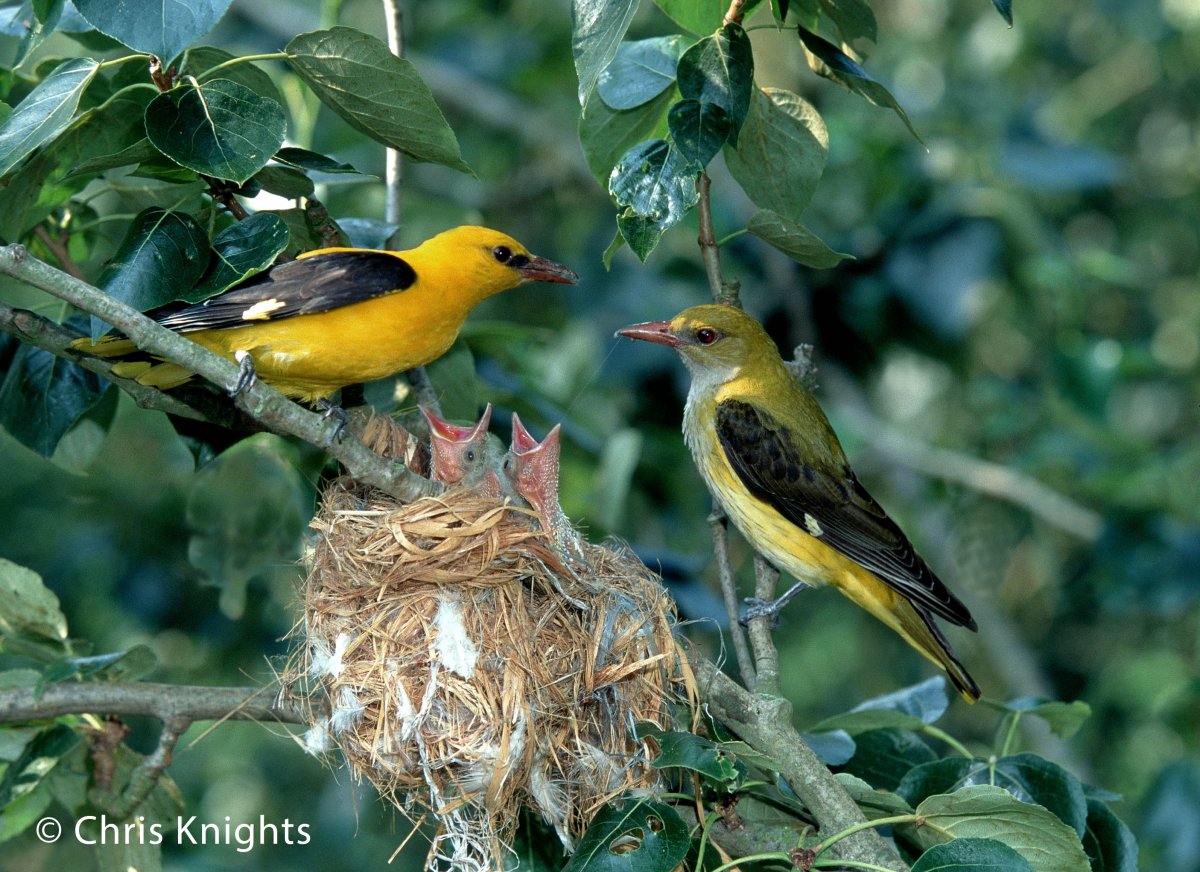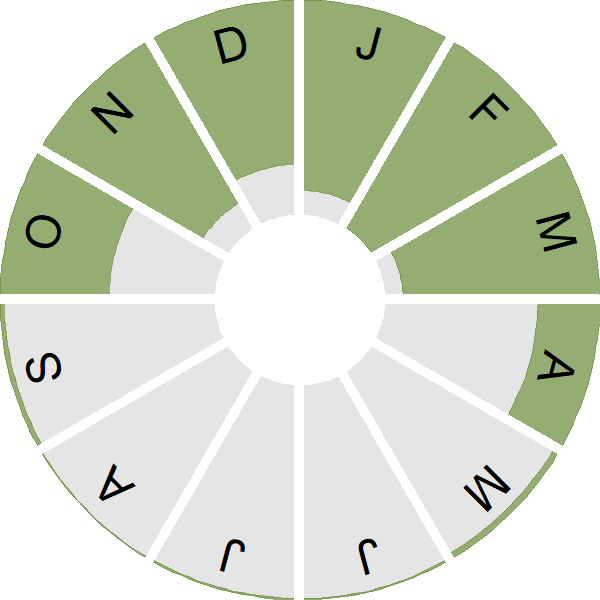White-fronted Goose

Introduction
This small, grey goose with white forehead blaze and black belly-bars is a winter visitor to wetlands and coastal marshes.
Two races of White-fronted Goose occur in the UK: the nominate race albifrons, which breeds in western Russia and is referred to as Russian, or European White-fronted Goose, and flavirostris, which breeds in western Greenland and is called Greenland White-fronted Goose. Greenland White-fronted Geese occur in the north and west of Britain and Ireland, whilst Russian White-fronted Geese can be found in the south and east.
Wetland Bird Survey data show the range of sites where the two races winter, and it is estimated that 10,000–12,000 Greenland White-fronts and 1,000–2,000 Russian White-fronts spend the winter months here in the UK.

Key Stats
Identification
ID Videos
This section features BTO training videos headlining this species, or featuring it as a potential confusion species.
Grey Geese (Revisited)
Songs and Calls
Call:
Status and Trends
Conservation Status
Population Change
Two subspecies of White-fronted Goose winter in the UK, with little range overlap. The 'European' albifrons subspecies winters mainly in southern England, although there are isolated records across other parts of the UK. WeBS data show a 75% decline in the wintering population between 1996/97 and 2021/22 Woodward et al. 2024. The 'Greenland' flavirostris subspecies winters predominantly in Northern Ireland, western and northern Scotland and the Republic of Ireland; it has a larger wintering population than the European subspecies. Data from dedicated Greenland White-fronted Goose counts also show a sharp decline in the wintering population over the past 25 years (1996/97 - 2021/22), although the decline has slowed in recent years Woodward et al. 2024.
Distribution
Two distinctive subspecies of White-fronted Goose winter in Britain and Ireland. There is little range overlap, with the 'European' (albifrons) subspecies occurring mainly in southern England, and the 'Greenland' (flavirostris) subspecies occurring predominantly in Ireland and western and northern Scotland.
Occupied 10-km squares in UK
2007/08–10/11
or view it on Bird Atlas Mapstore.
2008–11
or view it on Bird Atlas Mapstore.
European Distribution Map
Distribution Change
The two subspecies of White-fronted Goose were not reported separately during the 1981–84 Winter Atlas, thereby limiting range-change calculations to the species level. Nevertheless, knowledge of the general distribution of the two forms helps when interpreting the change map, which shows a 10% range contraction in Ireland compared with a 36% expansion in Britain, most notably in south-east England, along the east coast of England and in south and east Scotland.
Change in occupied 10-km squares in the UK
from 1981–84 to 2007–11
or view it on Bird Atlas Mapstore.
Seasonality
White-fronted Geese are winter visitors, present from October to April, with occasional stragglers and naturalised birds at other times.
Weekly pattern of occurrence
The graph shows when the species is present in the UK, with taller bars indicating a higher likelihood of encountering the species in appropriate regions and habitats.

Movement
Britain & Ireland movement
Foreign locations of birds ringed or recovered in Britain & Ireland
Dots show the foreign destinations of birds ringed in Britain & Ireland, and the origins of birds ringed overseas that were subsequently recaptured, resighted or found dead in Britain & Ireland. Dot colours indicate the time of year that the species was present at the location.
- Winter (Nov-Feb)
- Spring (Mar-Apr)
- Summer (May-Jul)
- Autumn (Aug-Oct)

European movements
EuroBirdPortal uses birdwatcher's records, such as those logged in BirdTrack to map the flows of birds as they arrive and depart Europe. See maps for this species here.
The Eurasian-African Migration Atlas shows movements of individual birds ringed or recovered in Europe. See maps for this species here.
Biology
Productivity and Nesting
Nesting timing
Egg measurements
Clutch Size
Survival and Longevity
Survival is shown as the proportion of birds surviving from one year to the next and is derived from bird ringing data. It can also be used to estimate how long birds typically live.
View number ringed each year in the Online Ringing Report.
Lifespan
Survival of adults
Survival of juveniles
Biometrics
Wing length and body weights are from live birds (source).
Ring Size
Classification, names and codes
Classification and Codes
- Order: Anseriformes
- Family: Anatidae
- Scientific name: Anser albifrons
- Authority: Scopoli, 1769
- BTO 2-letter code: WG
- BTO 5-letter code: WHFGO
- Euring code number: 1590
Alternate species names
- Catalan: oca riallera grossa
- Czech: husa belocelá
- Danish: Blisgås
- Dutch: Kolgans
- Estonian: suur-laukhani
- Finnish: tundrahanhi
- French: Oie rieuse
- Gaelic: Gèadh-bhlàr
- German: Blässgans
- Hungarian: nagy lilik
- Icelandic: Blesgæs
- Irish: Gé Bhánéadanach
- Italian: Oca lombardella
- Latvian: baltpieres zoss
- Lithuanian: baltakakte žasis
- Norwegian: Tundragås
- Polish: ges bialoczelna
- Portuguese: ganso-de-testa-branca
- Slovak: hus bielocelá
- Slovenian: belocela gos
- Spanish: Ánsar careto
- Swedish: bläsgås
- Welsh: Gwydd Dalcenwen
Research
Causes of Change and Solutions
Causes of change
The decline in the Greenland subspecies of White-fronted Goose has been established as being due to productivity rates being too low to balance mortality rates, however, the environmental drivers of this are unclear. Potential causes include climate change, density-dependent resource availability (caused by competition with Canada Geese which have expanded their range into Greenland), and changes in diet leading to poorer condition and lower female productivity. Human disturbance, loss or modification of wetland feeding habitats, unsustainable hunting and collisions with wind farms have been identified as drivers of local declines [Stroud et al. 2012]. It is thought that the decline in the European White-fronted Goose population in the UK is a result of short-stopping, with birds wintering further east than previously, particularly in the Netherlands where feeding conditions may have improved, winters are milder and hunting pressures are reduced [Hearn 2004].
Publications (1)
The risk of extinction for birds in Great Britain
Author: Stanbury, A., Brown, A., Eaton, M., Aebischer, N., Gillings, S., Hearn, R., Noble, D., Stroud, D. & Gregory, R.
Published: 2017
The UK has lost seven species of breeding birds in the last 200 years. Conservation efforts to prevent this from happening to other species, both in the UK and around the world, are guided by species’ ...
01.09.17
Papers

More Evidence
More evidence from Conservation Evidence.com
Partners
Citing BirdFacts
If you wish to cite particular content in this page (e.g. a specific value) it is best to use the original sources as linked in the page. For a more general citation of the whole page please use: BTO (20XX) BirdFacts Species: profiles of birds occurring in the United Kingdom. BTO, Thetford (www.bto.org/birdfacts, accessed on xx/xx/xxxx).

